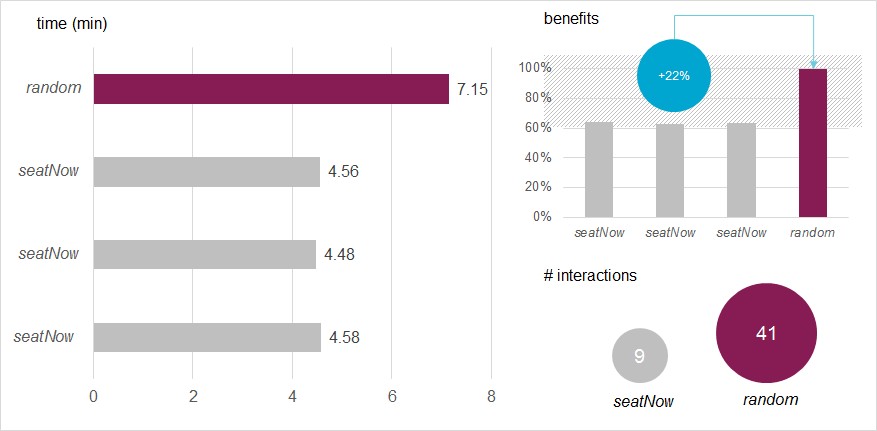Handling processes on the ground essentially determine the punctuality of commercial aircraft operations. Passenger boarding is the last and a critical handling process and comes with a particular challenge: boarding is significantly influenced by individual abilities, skills, and peculiarities of passengers. With the dynamic seating allocation seatNow, passengers receive their aircraft seat at the boarding pass control (via app or ticket), depending on their preferences (e.g., window seat, group seats) and on the passengers boarded before. This eliminates the time-consuming, uncomfortable, and inefficient pre-sorting process of passengers at the gate. The innovative process digitalization and automation of seatNow accelerate passenger boarding by 20-30% in the simulation environment and 22% at live trials with Eurowings at Cologne Bonn airport.
Test with Eurowings at Cologne Bonn Airport
The boarding test was set up with 73 participants with an Airbus A319 (D-AGWO) at Gate C10 of Cologne Bonn Airport (cf. connected cabin). The experiment was supported by the airport and Eurowings airline. A total of nine representative boarding procedures were carried out, recorded, and evaluated. To cover an operational seat load factor, 14 rows of the A319 were used for boarding (equivalent to a seat load factor of almost 87%). The nine boarding sessions consisted of two reference measurements with a standard procedure (random boarding, no seat assignment), three measurements with the fast outside-in procedure (first window seats followed by center seats and finally aisle seats, outside-in) and four boarding sessions with the dynamic seatNow concept. This test design ensured that passengers were not aware of the current boarding procedure. The boarding began with a standardized announcement at the gate and the passengers arrived at the gate in random or outside-in order. In the case of seatNow boarding, the passengers got the assigned seat ticket after the boarding gate.
Results
As expected, the fast outside-in boarding reduced the boarding time by 13% compared to random boarding. The seatNow procedure was much faster and enabled time savings of 22%. Furthermore, the response of the participants was very positive. Especially the seamless transfer, by means of significantly reduced (negative) interactions between the passengers, results in comfort improvements (see the following figure). Thus, it is expected that seatNow will also be accepted by passengers during real operations.

References
- Michael Schultz (to be published). Dynamic seat allocation
- Michael Schultz (2020). Seamless boarding concepts
- Michael Schultz (2018). Flugzeugboarding – Dynamisch und effizient
The complete list of publications can be found here: references.
